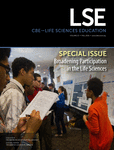Broadening the Study of Participation in the Life Sciences: How Critical Theoretical and Mixed-Methodological Approaches Can Enhance Efforts to Broaden Participation
Abstract
This research methods Essay details the usefulness of critical theoretical frameworks and critical mixed-methodological approaches for life sciences education research on broadening participation in the life sciences. First, I draw on multidisciplinary research to discuss critical theory and methodologies. Then, I demonstrate the benefits of these approaches for researchers who study diversity and inclusion issues in the life sciences through examples from two critical mixed-methods studies of prominent issues in science, technology, engineering, and mathematics (STEM) participation and recognition. The first study pairs critical discourse analysis of the STEM workforce literature, data, and underlying surveys with quantitative analyses of STEM pathways into the workforce. This example illustrates the necessity of questioning popular models of retention. It also demonstrates the importance of intersecting demographic categories to reveal patterns of experience both within and between groups whose access to and participation in STEM we aim to improve. The second study’s critical approach applies research on inequities in prizes awarded by STEM professional societies toward organizational change. This example uses data from the life sciences professional societies to show the importance of placing data within context to broaden participation and understand challenges in creating sustainable change.



